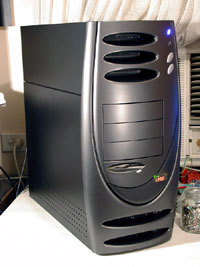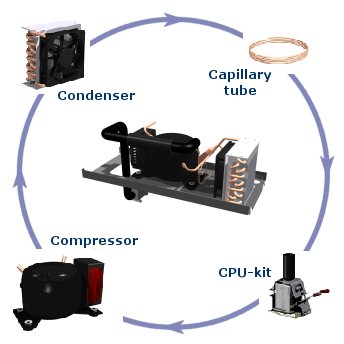|
|
|
|
|
Asetek VapoChill Mk2 Premium Edition |
|
Join the community - in the OCAU Forums!
|
Introduction, Phase-Change Theory
Asetek were one of the first companies to offer a complete below-ambient cooling system for consumer PC's - their VapoChill product. They have recently updated their range with the Mk 2 system, available in Standard Edition or Premium Edition, and in Titanium finish or plain White. We have featured their earlier product in various reviews and articles on OCAU and they contacted us to provide a VapoChill Mk2 Premium Edition in Titanium finish for use as a long-term testbed.

What makes the VapoChill so different, from a cooling perspective, to the vast range of air-coolers currently available? The fundamental difference is that with an air-cooler, you're only ever going to get down to a few degrees above the temperature of the air inside your case. Lots of in-case airflow, an extremely efficient heatsink and a monster cooling fan will get you closer, but with the penalty of extreme noise. If you're overclocking and overvolting, you're still going to get on-die CPU temperatures well above ambient. With the VapoChill system emitting a low hum we were able to idle our CPU at -3C. That's MINUS three. How? Vapour phase-change cooling, baby. Just like your refrigerator and freezer, but with all that cooling power centred on a tiny spot of copper pressed against the top of your CPU.
Vapour Phase-Change Cooling?
In simple terms, a phase-change cooler works like a water-cooling system - it uses a fluid to take heat energy from one place to another place where it is radiated or convected out into the atmosphere. A phase-change system is more complicated, and more effective, because it manipulates the pressure of the fluid and changes it from a liquid to a gas and back again. This is called changing the phase of the fluid, hence the name.
This next little section explains refrigeration theory in some detail. If you already know how your fridge works, skip ahead - but while researching this article I discovered a few holes and misconceptions in my own understanding of how it works. For example, I couldn't get my head around the use of the condenser or radiator in the system. If we're cooling something to below ambient temperatures, the coolant must be well below ambient, so surely running it through a radiator would HEAT it? I found the answer to that and other questions, so maybe you'll learn something too.
The Refrigeration Cycle
Here's an explanation of the VapoChill system in 4 basic parts - and I'll refer to a household refrigerator as an example also. This is based on information available on VapoChill's own website, with additional information from around the net, my own limited knowledge and the brain of Brad, my brother-in-law and a refrigeration mechanic by trade.

Compressor
The compressor is perhaps the most recognizeable part. If you've ever seen inside the bottom or back of a refrigerator you will have seen a similar squat sphere or cylinder. When refrigerant enters the compressor, it is relatively warm and at low pressure. Functioning basically like a pump, it compresses the refrigerant and provides pressure to force it around the rest of the cooling system. When you compress a gas, two things happen - firstly you raise its temperature and secondly you raise its boiling point and dew point. The first change means that, as it exits the compressor, the refrigerant is actually above ambient temperature. The second change means that it can become a liquid at room temperature, whereas if it hadn't been pressurised it would stay a gas at room temperature.
Condenser (or radiator)
As the hot, high-pressure gas flows through the condenser, it radiates heat into the ambient air and cools down. When it cools below the dew point, it condenses back into a liquid - the first phase change. Remember that this is only possible because it is under high pressure, so its dew point is artificially high. This process is how the heat is released from the otherwise closed system. In your refrigerator, the extensive coil system that runs probably the full height of the back of the unit is the condenser. That's why the back of the fridge feels warm - it's radiating the heat removed from inside the fridge and also heat created when the refrigerant was compressed. In the VapoChill this is a front-mounted radiator similar to those seen in watercooling systems, with a 120mm fan forcing ambient-temperature air through it to accelerate the cooling process.
Capillary Tube
We've removed a fair bit of heat from the refrigerant - it's now a high-pressure liquid at roughly ambient temperature. However, what we want to send to the evaporator is very cold refrigerant. Remembering from above that pressure and temperature are closely linked, the way that we will lower the temperature of the coolant is to lower its pressure. The capillary tube is a "metering device" that controls the flow of refrigerant. As it exits the capillary tube the pressure drops rapidly, taking the temperature with it - well below ambient and in this case, well below 0C. This now low-pressure, extremely low-temperature refrigerant floods the evaporator.
Evaporator (or CPU-kit)
This is where the magic happens! The evaporator, like the condenser, is where the cooling system meets the outside world. In your refrigerator, the evaporator is inside the walls and back of the unit. In the freezer, you can sometimes see an exposed metal plate which is extremely cold - this is the evaporator. In the VapoChill, the evaporator is fastened to the CPU socket and a 1mm thick copper disk presses against the CPU core. On the other side of the disk, inside the evaporator, extremely cold refrigerant absorbs the heat load of the CPU and evaporates. Remember, the refrigerant can be as low as -30C inside the evaporator, so even ambient air touching the evaporator core would be enough to make it evaporate. Throw 50-100W or more of heat load from a CPU and this second phase-change can be dramatic. Carrying the heat energy away, the warmer (but still fairly cold) refrigerant vapour is sucked back into the compressor and the cycle begins again.
The net result of all this is that the CPU core, pressed against the evaporator, becomes extremely cold. We observed an on-die temperature of -3C reported by Motherboard Monitor for our P4 test CPU. Considering we're in the middle of a long hot summer here in Sydney, Australia, that is well below ambient and impossible for any conventional aircooler or even watercooling.
As any overclocker knows, the cooler you can get your CPU to run, the better it is for speed and stability. The ultra-low CPU temperature in the VapoChill will of course allow us to run the CPU faster than ever. But before we get too carried away, let's return to reality and take a look at the VapoChill case in detail, on the next page.
|
|
Advertisement:
All original content copyright James Rolfe.
All rights reserved. No reproduction allowed without written permission.
Interested in advertising on OCAU? Contact us for info.
|

|


